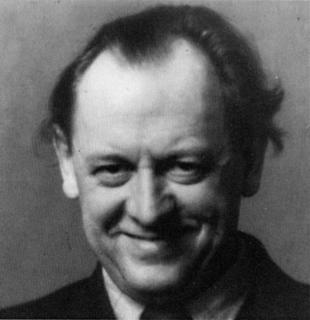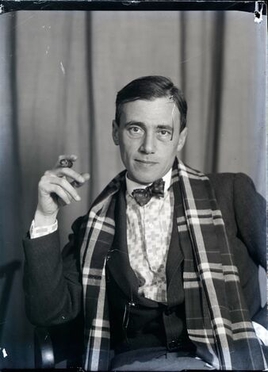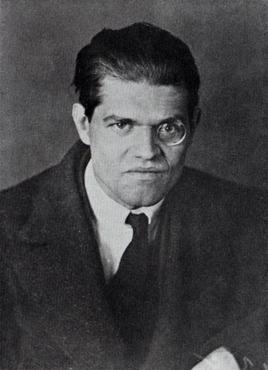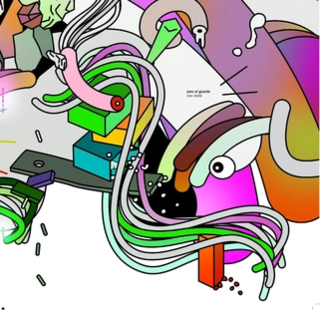Neo-Dada was an art movement.
Neo-Dada may also refer to:
- Neo-Dada Organizers, a Japanese art collective
- Neo Dada (album), 2009 album by Jono El Grande
Neo-Dada was an art movement.
Neo-Dada may also refer to:

Dada or Dadaism was an art movement of the European avant-garde in the early 20th century, with early centres in Zürich, Switzerland, at the Cabaret Voltaire, founded by Hugo Ball with his companion Emmy Hennings, and in Berlin in 1917. New York Dada began c. 1915, and after 1920 Dada flourished in Paris. Dadaist activities lasted until the mid 1920s.

Kurt Hermann Eduard Karl Julius Schwitters was a German artist. He was born in Hanover, Germany, but lived in exile from 1937.

HansRichter was a German Dada painter, graphic artist, avant-garde film producer, and art historian. In 1965 he authored the book Dadaism about the history of the Dada movement. He was born in Berlin into a well-to-do family and died in Minusio, near Locarno, Switzerland.

In the arts and in literature, the term avant-garde identifies an experimental genre, or work of art, and the artist who created it; which usually is aesthetically innovative, whilst initially being ideologically unacceptable to the artistic establishment of the time. The military metaphor of an advance guard identifies the artists and writers whose innovations in style, form, and subject-matter challenge the artistic and aesthetic validity of the established forms of art and the literary traditions of their time; thus, the artists who created the anti-novel and Surrealism were ahead of their times.

Fluxus was an international, interdisciplinary community of artists, composers, designers, and poets during the 1960s and 1970s who engaged in experimental art performances which emphasized the artistic process over the finished product. Fluxus is known for experimental contributions to different artistic media and disciplines and for generating new art forms. These art forms include intermedia, a term coined by Fluxus artist Dick Higgins; conceptual art, first developed by Henry Flynt, an artist contentiously associated with Fluxus; and video art, first pioneered by Nam June Paik and Wolf Vostell. Dutch gallerist and art critic Harry Ruhé describes Fluxus as "the most radical and experimental art movement of the sixties".
An art movement is a tendency or style in art with a specific art philosophy or goal, followed by a group of artists during a specific period of time, or, at least, with the heyday of the movement defined within a number of years. Art movements were especially important in modern art, when each consecutive movement was considered a new avant-garde movement. Western art had been, from the Renaissance up to the middle of the 19th century, underpinned by the logic of perspective and an attempt to reproduce an illusion of visible reality. By the end of the 19th century many artists felt a need to create a new style which would encompass the fundamental changes taking place in technology, science and philosophy.

Cabaret Voltaire was the name of a short-lived artistic nightclub in Zürich, Switzerland in 1916. It was founded by Hugo Ball, with his companion Emmy Hennings, in the back room of Holländische Meierei, Spiegelgasse 1, on February 5, 1916, as a cabaret for artistic and political purposes. Other founding members were Marcel Janco, Richard Huelsenbeck, Tristan Tzara, Sophie Taeuber-Arp and Jean Arp.
Neo-Dada was a movement with audio, visual and literary manifestations that had similarities in method or intent with earlier Dada artwork. It sought to close the gap between art and daily life, and was a combination of playfulness, iconoclasm, and appropriation. In the United States the term was popularized by Barbara Rose in the 1960s and refers primarily, although not exclusively, to work created in that and the preceding decade. There was also an international dimension to the movement, particularly in Japan and in Europe, serving as the foundation of Fluxus, Pop Art and Nouveau réalisme.

Raoul Hausmann was an Austrian artist and writer. One of the key figures in Berlin Dada, his experimental photographic collages, sound poetry, and institutional critiques would have a profound influence on the European Avant-Garde in the aftermath of World War I.

Anti-art is a loosely used term applied to an array of concepts and attitudes that reject prior definitions of art and question art in general. Somewhat paradoxically, anti-art tends to conduct this questioning and rejection from the vantage point of art. The term is associated with the Dada movement and is generally accepted as attributable to Marcel Duchamp pre-World War I around 1914, when he began to use found objects as art. It was used to describe revolutionary forms of art. The term was used later by the Conceptual artists of the 1960s to describe the work of those who claimed to have retired altogether from the practice of art, from the production of works which could be sold.

Fountain is a readymade sculpture by Marcel Duchamp in 1917, consisting of a porcelain urinal signed "R. Mutt". In April 1917, an ordinary piece of plumbing chosen by Duchamp was submitted for the inaugural exhibition of the Society of Independent Artists, to be staged at the Grand Central Palace in New York. When explaining the purpose of his readymade sculpture, Duchamp stated they are "everyday objects raised to the dignity of a work of art by the artist's act of choice." In Duchamp's presentation, the urinal's orientation was altered from its usual positioning. Fountain was not rejected by the committee, since Society rules stated that all works would be accepted from artists who paid the fee, but the work was never placed in the show area. Following that removal, Fountain was photographed at Alfred Stieglitz's studio, and the photo published in the Dada journal The Blind Man. The original has been lost.

Jono El Grande is the stage name of Jon Andreas Håtun.
Dada, or Dadaism, was an early 20th century art movement
Twentieth-century art—and what it became as modern art—began with modernism in the late nineteenth century.

Dada Life are a Swedish DJ duo formed in 2006, which consists of Olle Cornéer and Stefan Engblom. They have released three albums, a number of singles and remixes and one compilation. The duo had early chart success in Belgium and the Netherlands, while their second album The Rules of Dada reached the Billboard 200. They are known for their humour during their live performances, while their name is a homage to the absurdist movement of the early twentieth century. They have released two audio plugins programmed by Tailored Noise: Endless Smile, a drop editor plugin and Sausage Fattener, a saturator.

Neo Dada is a music album by the Norwegian composer and artist Jono El Grande, released by Rune Grammofon on 16 March 2009.
"Love to Say Dada" is an unfinished song that was written by American musician Brian Wilson for the Beach Boys' Smile project. It referenced the drug LSD in its initials and was one of the last tracks recorded for the album. The song subsequently evolved into "Cool, Cool Water" from Sunflower (1970).
Neo-Dadaism Organizers, sometimes shortened to Neo-Dada Organizers or simply Neo-Dada (ネオ・ダダ), was a short-lived but influential Japanese Neo-Dadaist art collective formed by Masunobu Yoshimura in 1960. Composed of a small group of young, up-and-coming artists who met periodically at Yoshimura's "White House" atelier in Shinjuku, the Neo-Dada Organizers engaged in all manner of visual and performance artworks, but specialized in producing disturbing, impulsive spectacles, often involving physical destruction of objects, that the art critic Ichirō Hariu deemed "savagely meaningless," and that inspired another art critic, Yoshiaki Tōno, to coin the term "anti-art" (han-geijutsu). Examples included filling galleries with piles of garbage, smashing furniture to the beat of jazz music, and prancing the streets of Tokyo in various states of dress and undress. Using the human body as their medium of art, their violent performances reflected both their dissatisfaction with the restrictive environment of the Japanese art world at the time, as well as contemporary social developments, most notably the massive 1960 Anpo protests against the U.S.-Japan Security Treaty.
Masunobu Yoshimura, was a Japanese visual and conceptual artist associated with the Neo-Dada movement. In 1960, he was the founder and leader of the short-lived but influential artistic collective Neo-Dada Organizers, which had as members several young artists who would later become well-known, including Genpei Akasegawa, Shūsaku Arakawa, and Ushio Shinohara. His "White House" atelier in Shinjuku, Tokyo served as the center of the group's activities.